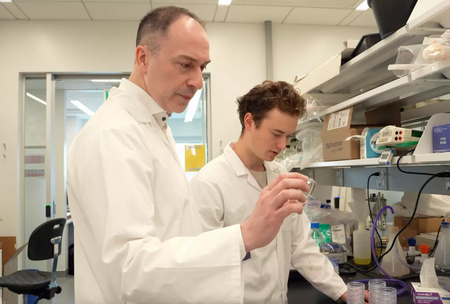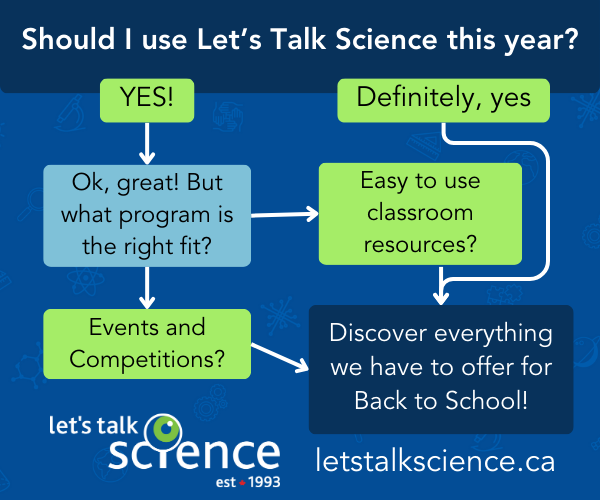
The new cancer research hub supports Aaron Goodarzi and his team as they work to deepen our understanding of the causes of lung cancer. Photo Credit: Phil Crozier
When people think of lung cancer, they often associate it with tobacco smoking. However, the second leading cause of lung cancer in Canada is radon, which poses a greater health risk in Canada than in many other parts of the world.
Radon is a naturally occurring, odourless and colourless gas that rises to the surface from the ground. In the outside air, it dissipates. However, in residential buildings, this gas can become trapped and accumulate over time, creating a health hazard for anyone breathing it in.
Many Canadians don't realize the gas is the greatest source of cancer-causing radiation over a lifetime and is most often encountered where they live, says Dr. Aaron Goodarzi, BSc'99, PhD'05, a professor at the University of Calgary's Cumming School of Medicine (CSM) and lead of the Evict Radon National Study.
"That's why I started many years ago studying the health effects of radon, which is, to put it short, lung cancer," says Goodarzi. "Radon emits radiation inside our lungs because we breathe it in, and that drives our cells towards a state of DNA damage and mutation that increases the risk of developing lung cancer."
Goodarzi and his team are investigating how we are exposed to radon, the extent of that exposure, and what can be done to mitigate it, in the new Environmental Cancer Research Hub located at the Arnie Charbonneau Cancer Institute. This unique facility offers state-of-the art technology and, for experts from multiple disciplines, the lab serves as a place to study environmental causes of lung cancer, such as exposure to air pollutants like wildfire smoke, and how the buildings we live and work in impact our exposure to radon.
Healthy buildings to live, work and play in
The attitudes of Canadians, architects and builders are changing when it comes to built-environment health, says Dr. Joshua Taron, PhD, associate dean (research and Innovation) at the School of Architecture, Planning and Landscape.
"I think, as we make efforts, especially through things like the Evict Radon National Study, to educate the public, and there's a broader appetite for having healthy buildings, sustainable buildings, healthy environments, people will pay attention to it more and that demand will be there," says Taron. "I think there'll be a greater and greater focus on how buildings contribute to either alleviating those issues or exacerbating them, and finding ways to design better ways forward."
A medical lens on lung cancer
Patients are often shocked when they discover they have lung cancer, despite being non-tobacco smokers, says medical oncologist Dr. Doreen Ezeife, MD, a CSM clinical associate professor, who often recommends her patients test their houses for radon.
"I think all of us should test whether we have a lung cancer diagnosis or not," says Ezeife. "I think that, in Alberta and in Canada, it's important to be informed about the radon levels in our homes."
Along with gaining a better understanding of lung cancer caused by environmental exposure, the researchers are also studying specific DNA mutations caused by exposure to the type of radiation emitted by radon that are linked to an increased risk of developing lung cancer.

Aaron Goodarzi and MSc student Austin Atkins in the Environmental Cancer Research Hub. Photo Credit: Samantha Lafleur
Confirming the environmental risks we've been exposed to
Dr. Mike Wieser, PhD, a professor of physics and astronomy in the Faculty of Science, is working with a new state-of-the-art mass spectrometer linked with a first-of-its-kind-in-Canada metallomics laboratory, where scientists can measure the level of metals that have been absorbed into the body and have collected in our cells. Signs of lung cancer-associated environmental exposures can be detected in human tissue, like toenails.
The technologies being developed in this facility are innovating new ways to reveal what people have been exposed to, by how much, and how that may be impacting their health.
Wieser, BSc'91, MSc'94, PhD'98, says transdisciplinary work is vital; he recently attended the Radiation and Air Pollution Induced Disease (RAPID) Prevention and Early Detection Workshop. The RAPID workshop series, hosted by UCalgary and first held on campus in 2019, is among the first of a new kind of scientific meeting that brings scientists, architects, epidemiologists, health services professionals and patient-partners together to discuss ways to study and prevent environmental causes of lung cancer.
"I think the more voices, the more perspectives you can bring together in a room, the more likely you can come up with real practical and impactful solutions," Wieser says. "Having the diversity of opinions at the table is critical, and it allows us to innovate and come up with ideas, knowledge and experience around solutions that can change the world and can change people's lives. So, I think it's a wonderful opportunity."
A wonderful opportunity Goodarzi hopes to continue to foster.
"A transdisciplinary approach to research and development is crucial in understanding and preventing cancer because it brings together the vitally diverse expertise that is needed to address complex challenges," Goodarzi says. "By integrating knowledge from the environmental, building, earth and life sciences, together with oncology, public health and engineering, researchers can work directly with policymakers, communicators and health advocates to develop comprehensive strategies and new tools for risk assessment, prevention and treatment.
"Such a fundamentally collaborative effort not only enhances our understanding of how environmental factors contribute, but also fosters innovative solutions that are more effective in safeguarding public health."
To sign up for the study and get your home tested, visit the Evict Radon National Study webpage.
Aaron Goodarzi is a professor in the departments of Biochemistry & Molecular Biology and Oncology at the Cumming School of Medicine (CSM). He is the lead of the Evict Radon National Study and the director of the Robson DNA Science Centre, and director of the Charbonneau Microscopy Facility at the Arnie Charbonneau Cancer Institute at the CSM.
Mike Wieser is a professor in the Department of Physics and Astronomy in the Faculty of Science and also member of the Arnie Charbonneau Cancer Institute at the CSM.
Josh Taron is associate dean (Research and Innovation) at the School of Architecture, Planning and Landscape where he runs the Laboratory for Integrative Design.
Doreen Ezeife is a clinical associate professor in the Department of Oncology at the Cumming School of Medicine (CSM) and a member of the Arnie Charbonneau Cancer Institute at the CSM.
The Arnie Charbonneau Cancer Institute
The Arnie Charbonneau Cancer Institute brings together scientists and clinicians to integrate research and care cross disciplines - from understanding and preventing cancer, to transforming its detection and treatment, to improving life with and after cancer. Learn more about Charbonneau.













